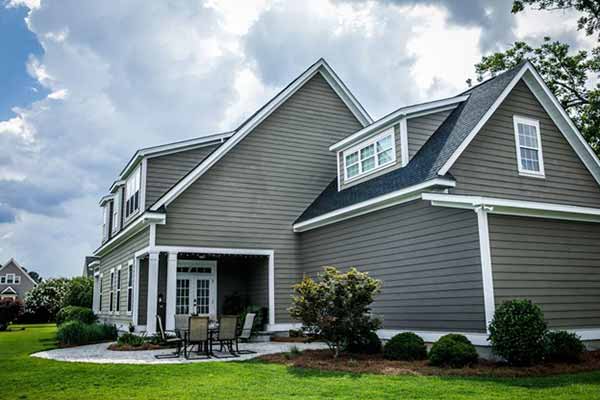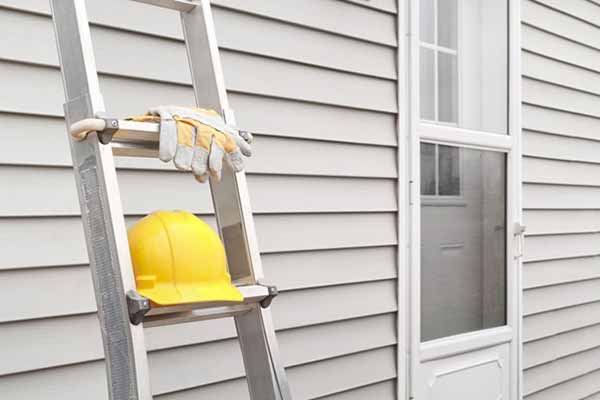If you’re looking for ways to lower your energy bill, you might consider energy-efficient siding.
Siding or cladding is a protective material installed on the exterior walls of a building. Different materials can be used for siding, although not all siding options are equally energy-efficient.
A home is energy efficient when its construction and operation use minimal electricity. The less overall energy homeowners consume, the less they contribute to the world’s total carbon emissions.
This article discusses the benefits of energy-efficient siding, the various siding options, the materials that can improve your home’s insulation, and when it might be time to install new siding.
What Are the Benefits of Energy-Efficient Siding?
Energy-efficient siding can help homeowners support the environment by lowering their energy use. The building material chosen for siding can reduce energy costs and improve energy efficiency.
Energy-efficient siding improves the insulation of your home. It shields a building from harsh elements such as the sun, wind, snow, or rain and helps maintain its internal temperature by preventing air and moisture leaks.
Insulation makes your home or building more comfortable, keeps your utility bills down, and improves your property’s resale value.
What Is R-Value and How Does It Help Insulation?
The thermal resistance of insulation materials is measured in R-value. The R-value of an insulator indicates how well it retains heat per inch of depth. Therefore, the insulation capability of building material will also depend on its thickness. For example, a thin foam insulation panel might have a high R-value but offer much the same protection as a thick panel with a lower R-value.
Energy-efficient siding will have a good R-value, and the higher the R-value, the more effectively the material insulates your home or building. However, a higher R-value also means that the material will be more expensive.
What Are the Different Siding Options?
Siding can be manufactured from different materials at different price points. Below is a breakdown of the most common types of siding and how each will likely influence your utility bills.
Fiber Cement Siding
Fiber cement siding is low maintenance and durable. The material is strong enough to provide protection but still adequately flexible. Fiber cement siding is generally more cost-effective than synthetic stucco and wood but more expensive than vinyl. It often comes with a warranty of 25 years or more. Moreover, this material is non-combustible, moisture-resistant, and won’t attract termites and other pests.
Nevertheless, with an R-value of under 1, fiber cement siding does not provide much insulation when used on its own.
Steel Siding
Metal siding or steel siding is becoming a popular choice for homeowners since this material is long-lasting, strong, and requires little upkeep. Because steel siding deflects sun rays away from a building, it makes for energy-efficient siding. Similar to fiber cement siding, metal doesn’t attract termites, eliminating the need for pest control.
The downside of metal is that it’s susceptible to dents and involves higher upfront costs. Also, steel isn’t a good insulator on its own and needs to be paired with insulation material to boost energy efficiency.
Wood Siding
Wood is a renewable, environment-friendly siding option, and it’s excellent for your home’s curb appeal. While people might be concerned about trees being cut down, wood is still one of the most sustainable options compared to others that contain harmful substances. Softwood has an R-value of 1.41. In contrast, hardwood has an R-value of only 0.71 per inch.
The biggest issue with wood siding is durability. Unlike fiber cement siding and steel siding, wood fibers disintegrate over time.
Aluminum Siding
The thickness of aluminum siding is key to its effectiveness. The best aluminum siding is 0.53 inches thick, making it optimally durable. If you opt for this thickness, you wouldn’t need replacement siding for about 35 years, but occasional repainting might be necessary.
Homeowners will also save on labor costs as this material is lightweight and easy to install. In addition, aluminum is waterproof and doesn’t rot or attract termites. Aluminum is a sustainable option because it’s recyclable and requires little energy to manufacture. As with metal, aluminum siding can dent and lose its color over time.
Enter your ZIP Code and compare electricity rates
The R-value of aluminum is 0.61, while insulated aluminum siding has an R-value of 2 to 5.
Manufactured Stone Veneer Siding
A stone exterior will do wonders for the curb appeal of your home. But because it’s an expensive siding option, many people opt for manufactured stone veneer. A faux stone veneer is strong and durable, with a lifetime of up to 75 years. It’s also fire-resistant and maintenance-free. However, if you hire an unqualified siding installer, water can become trapped behind manufactured stone veneer, causing dampness and mold on interior walls.
When paired with a layer of plastic and foam, manufactured stone veneer has an R-value of 4.5.
Composite Siding
This type of siding consists of various materials, most commonly scrap wood bound with resin. With impressive aesthetic appeal and a lifespan of about 30 years, composite siding is a popular choice for homeowners.
Nowadays, composite siding is treated to resist termites, rot, and water. The material is also impact-proof and robust since the resin protects the wood fibers. Unlike wood, composite siding doesn’t warp. Composite siding also provides good insulation with an R-value of 2 to 4.
The downside to composite siding is that it’s heavy and cumbersome to install.
Rigid Foam Sheathing
Rigid foam sheathing consists of solid plastic foam that provides excellent insulation with R-values between 3.8 and 6.8. Because it prevents heat loss, this siding product improves homes’ energy performance and energy efficiency. As with the other types of siding, rigid foam is applied to the exterior of a building. You can purchase this material in different thicknesses and R-values, and it’s sold in large sheets.
For rigid foam sheathing to provide optimal insulation and limit air leaks, it must be installed and sealed correctly. It’s also quite expensive. Nevertheless, because this material protects underlying structures, it reduces the upkeep of those structures.
Vinyl Siding
Vinyl is a common choice for energy-efficient siding. It’s durable, waterproof, and deflects sunlight — preventing warming rays from making a house even hotter in the summer. Another benefit of insulated vinyl siding is its durability and longevity. Since vinyl is low maintenance and can last more than 20 years, households don’t have to replace siding frequently. Therefore, they use fewer resources and less energy, making vinyl an attractive choice from a sustainability point of view.
However, vinyl siding has an R-value of under 1 when used by itself. If paired with foam or another form of insulation, the R-value increases to between 2 and 3.
Which Energy-Efficient Siding Is Best?
Most types of siding have a low R-value when used on their own. Fiber cement, steel, wood, aluminum, manufactured stone, and vinyl have R-values of under 1 when not used with another form of insulation.
Composite siding provides good insulation by itself, but rigid foam sheathing is by far the best insulator. Homeowners who choose one of these two siding options will improve their energy efficiency and save the most on energy bills.
Which Materials Improve the Energy Efficiency of Siding?
Steel siding requires a breathable, synthetic underlayment to insulate a building adequately. A breathable material will allow moisture to escape while preventing outside water from coming in. Similarly, wood siding requires a moisture barrier or tar paper to insulate properly.
Homeowners can install rigid foam insulation underneath aluminum siding to improve their energy efficiency. If they opt for vinyl siding, they require a house wrap as the first layer of protection and might even add a layer of foam insulation to improve the total R-value of their home’s siding.
Does New Siding Increase Energy Efficiency?
Natural elements will wear out and damage the siding of your house over time, reducing its energy efficiency. Here are a few clear signs that it’s time to replace your home’s siding.
- Indoor paint peels and wallpaper sags: As your home’s cladding wears out, it’ll become less durable, and outside moisture will seep through the walls. This will damage paint and wallpaper.
- Mold and mildew: Moisture from the outside will result in mold and mildew appearing on your walls and inside cupboards.
- Cracks in your siding: When there are holes or cracks in your home’s siding, it impacts your house’s curb appeal and exposes the underlying material to the elements. Cracks and holes also allow mice and insects to nest within your walls.
- Rotting, crumbling siding: Wood siding might become brittle and powdery over time.
- Higher heating and cooling bills: With age, cladding loses its effectiveness, which will show on your energy bills. Your energy usage will increase because it no longer protects your house from the elements.
Along with your roof and energy-efficient shingles, new siding will increase your energy efficiency by insulating your house from heat and cold. You won’t have to use your HVAC system as much to compensate for the airflow coming through the walls. With a couple of home improvements, you can make your home more energy-efficient.
When deciding on the best siding option, it’s crucial to consider the R-value of the material. However, it’s possible to improve the overall R-value of your siding by installing a breathable, synthetic fabric and rigid foam underneath.
Energy-Efficient Siding Can Positively Impact Your Energy Bill
There are dozens of ways to increase your energy savings by making some home improvements. You can take energy conservation into your own hands, from siding and insulation to HVAC upgrades or switching out your lightbulbs for their energy-efficient counterparts.
If you’re looking for one of the most energy-efficient ways to increase energy savings and lower your energy bill, energy-efficient siding may be the way to go.
Brought to you by energysavings.com
All images licensed from Adobe Stock.
Featured image:



